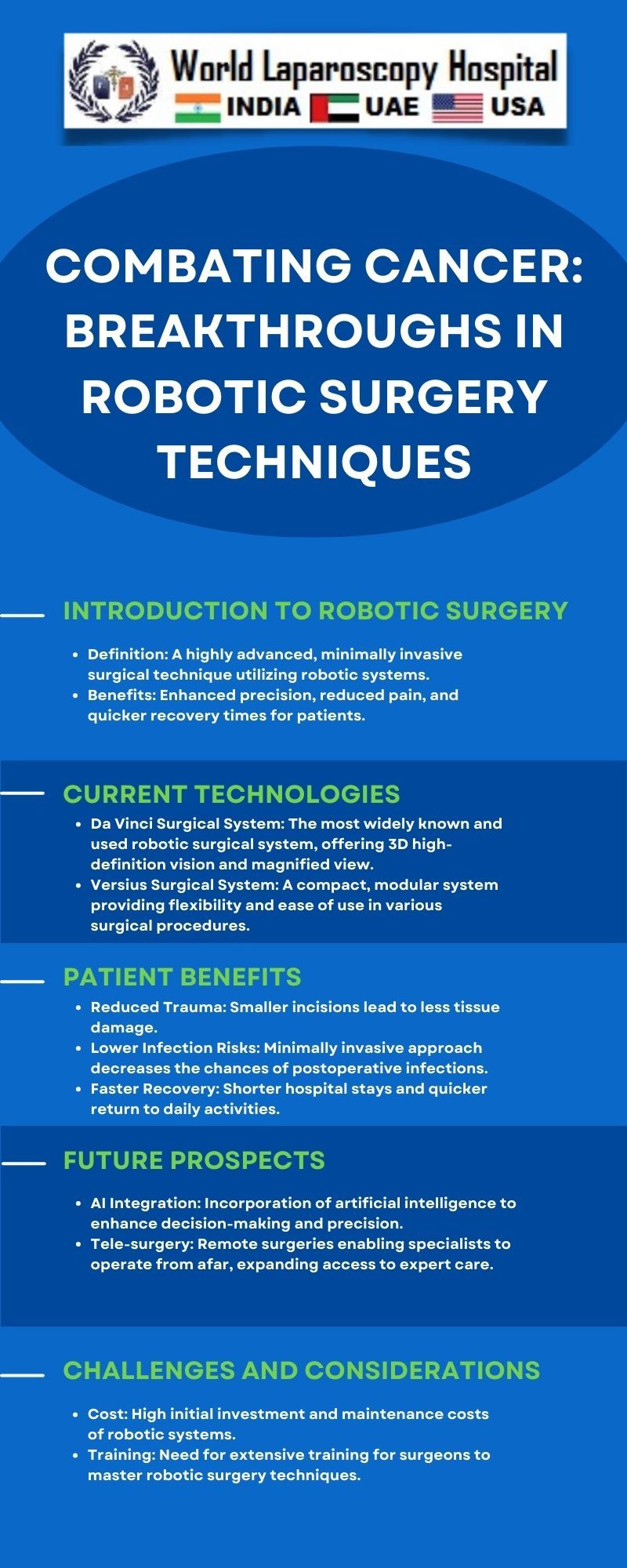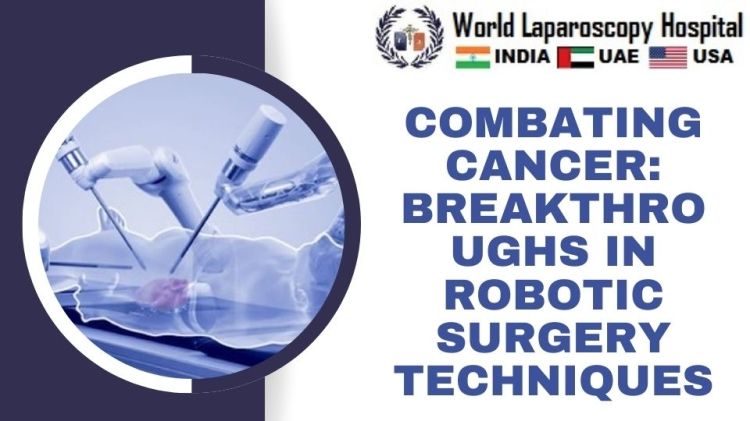Combating Cancer: Breakthroughs in Robotic Surgery Techniques
Introduction
Cancer continues to be a formidable adversary in the realm of healthcare, affecting millions of lives worldwide. In the ongoing quest to combat this disease, medical science has witnessed a groundbreaking revolution through the integration of robotic surgery techniques. This article delves into the intricacies of these breakthroughs, exploring how they are transforming cancer treatment, enhancing precision, and ultimately reshaping the landscape of patient care.

Understanding Robotic Surgery
Robotic surgery is an advanced form of minimally invasive surgery that utilizes robotic systems to assist surgeons in performing complex procedures with greater precision. Unlike traditional open surgery, where large incisions are made, robotic surgery involves small incisions through which specialized robotic arms, controlled by the surgeon, carry out precise movements with the help of a console. This technology offers several advantages, including reduced blood loss, shorter hospital stays, and faster recovery times.
Evolution of Robotic Surgery in Cancer Treatment
The use of robotic surgery in cancer treatment has evolved significantly over the past two decades. Initially employed in urological and gynecological procedures, robotic surgery is now making remarkable strides in various cancer specialties, including colorectal, thoracic, and head and neck surgeries.
Enhanced Precision and AccuracyOne of the primary advantages of robotic surgery in cancer treatment is the heightened precision and accuracy it provides. The robotic arms are equipped with specialized instruments that can mimic the movements of a human hand but with a greater range of motion. This allows surgeons to perform intricate tasks with unprecedented precision, enabling the removal of tumors with minimal damage to surrounding healthy tissues.
Minimally Invasive ApproachesRobotic surgery is inherently minimally invasive, with smaller incisions compared to traditional open surgery. This leads to reduced trauma to the body, decreased blood loss, and a lower risk of infection. Patients undergoing robotic surgery often experience less pain and discomfort, contributing to a faster and smoother recovery process.
Quicker Recovery TimesThe minimally invasive nature of robotic surgery translates into quicker recovery times for patients. As compared to traditional open surgery, where the healing process can be prolonged, robotic surgery allows patients to return to their daily activities sooner. This aspect is particularly crucial in cancer treatment, where early recovery can positively impact the overall prognosis and quality of life for patients.
Breakthroughs in Robotic Surgery Techniques
Recent breakthroughs in robotic surgery techniques have further elevated the capabilities of this innovative approach in cancer care.
Artificial Intelligence IntegrationThe integration of artificial intelligence (AI) with robotic surgery has been a game-changer. AI algorithms can analyze vast amounts of data, helping surgeons in real-time decision-making during procedures. This is particularly beneficial in identifying critical structures, optimizing surgical pathways, and enhancing overall procedural efficiency.
Haptic Feedback SystemsAdvancements in haptic feedback systems have addressed a longstanding limitation of robotic surgery – the lack of tactile feedback. Innovations in this area now enable surgeons to "feel" the tissues they are operating on, providing a more immersive and realistic experience. This breakthrough enhances the surgeon's ability to distinguish between healthy and cancerous tissues, further improving surgical precision.
Telesurgery and Remote AssistanceThe concept of telesurgery, where a surgeon can perform a procedure remotely using robotic systems, has gained traction. This is particularly valuable in areas with limited access to specialized medical expertise. Additionally, remote assistance capabilities allow experienced surgeons to guide and assist their counterparts in real-time, fostering collaboration and knowledge exchange.
Multi-Arm Robotic SystemsTraditional robotic surgery systems typically involve a console operated by the surgeon, controlling multiple robotic arms. Recent breakthroughs include the development of multi-arm robotic systems, allowing for even greater flexibility and efficiency during procedures. Surgeons can simultaneously use multiple robotic instruments, streamlining complex surgeries and reducing overall operative times.
Applications Across Cancer Specialties
The impact of robotic surgery breakthroughs is felt across various cancer specialties, each presenting unique challenges and opportunities for innovation.
Colorectal Cancer SurgeryIn colorectal cancer surgery, where precision is paramount, robotic systems offer distinct advantages. The intricate nature of procedures such as sphincter-preserving surgeries is facilitated by the dexterity and accuracy of robotic arms. Additionally, the improved visualization provided by robotic systems enhances the surgeon's ability to navigate complex anatomical structures.
Thoracic SurgeryRobotic-assisted thoracic surgery has become increasingly prevalent in the treatment of lung and esophageal cancers. The minimally invasive approach results in reduced trauma to the chest, leading to shorter hospital stays and faster recovery. The enhanced precision of robotic arms is particularly beneficial in intricate procedures like mediastinal lymph node dissections.
Head and Neck SurgeryIn the realm of head and neck cancer surgery, robotic systems offer a less invasive alternative to traditional approaches. The ability to navigate the narrow and complex anatomy of the head and neck region with greater precision is a significant advantage. This has led to improved functional outcomes, especially in procedures involving delicate structures like the vocal cords and swallowing mechanisms.
Challenges and Future Directions
While the advancements in robotic surgery for cancer treatment are promising, challenges and considerations must be addressed for widespread adoption and continued improvement.
Cost ImplicationsThe initial costs associated with acquiring and implementing robotic surgery systems can be substantial. This includes the cost of the robotic platform, specialized instruments, and ongoing maintenance. Overcoming these cost barriers is crucial to ensuring equitable access to this innovative technology.
Surgeon Training and Learning CurveThe adoption of robotic surgery requires specialized training for surgeons. The learning curve associated with mastering robotic techniques is a consideration, and ongoing education is essential for ensuring proficiency. Establishing robust training programs is crucial to expanding the pool of skilled robotic surgeons.
Standardization of ProtocolsAs robotic surgery becomes more widespread, standardization of protocols and procedures is essential. This includes defining best practices, optimizing surgical pathways, and establishing guidelines for patient selection. Standardization contributes to improved consistency in outcomes and facilitates collaboration among medical professionals.
Ethical ConsiderationsThe integration of AI in robotic surgery raises ethical considerations, including issues related to patient consent, data privacy, and the role of AI in decision-making during surgery. Addressing these ethical concerns is essential for maintaining patient trust and ensuring responsible use of technology in healthcare.
Looking Ahead: The Future of Robotic Surgery in Cancer Care
The future of robotic surgery in cancer care holds tremendous promise, with ongoing research and development focused on further enhancing the capabilities of this technology.
Nanorobotics and Targeted Drug DeliveryNanorobotics, a field that involves the use of microscopic robots, holds potential for targeted drug delivery directly to cancer cells. Integrating nanorobotics with robotic surgery platforms could revolutionize the way cancer is treated, allowing for precise and personalized delivery of therapeutic agents.
Augmented Reality and Virtual Reality IntegrationThe integration of augmented reality (AR) and virtual reality (VR) technologies with robotic surgery systems is an area of active exploration. These technologies can provide surgeons with enhanced visualization, three-dimensional reconstructions, and real-time navigation during procedures. This immersive experience has the potential to further improve surgical precision and outcomes.
Continued Advancements in AI
The role of artificial intelligence in robotic surgery is expected to evolve further. Machine learning algorithms can continually improve surgical outcomes by analyzing vast datasets and identifying patterns that contribute to enhanced decision-making. The synergy between AI and robotic surgery is likely to result in more personalized and effective cancer treatments.
Conclusion
Breakthroughs in robotic surgery techniques are revolutionizing the landscape of cancer care, offering patients new hope and improved outcomes. The marriage of robotics, artificial intelligence, and innovative technologies is propelling the field forward, enabling surgeons to navigate the complexities of cancer treatment with unprecedented precision. As we stand at the forefront of this transformative era, the continued collaboration between medical professionals, researchers, and technologists holds the key to unlocking even greater advancements in the fight against cancer.


